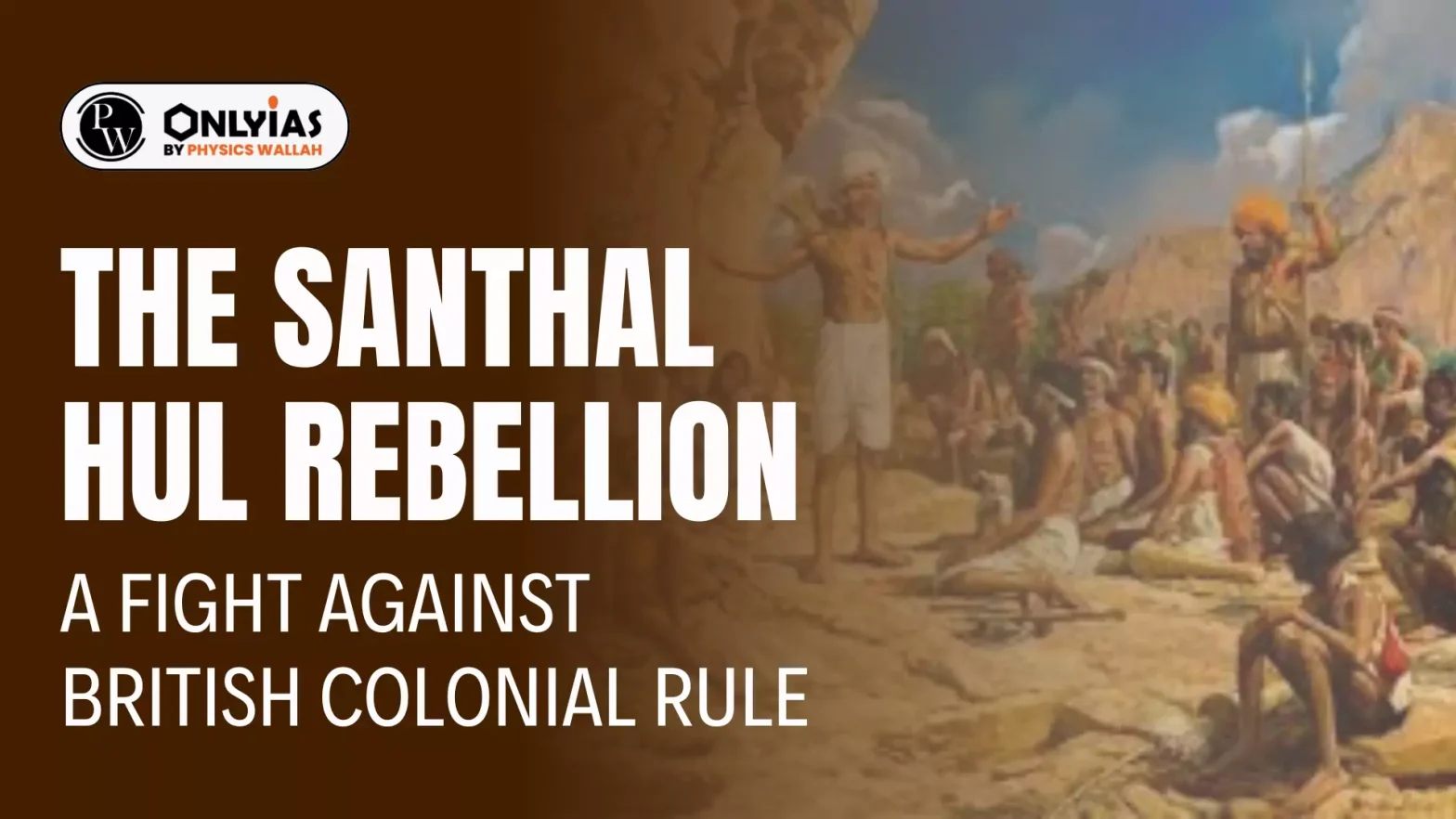The Santhal Hul Rebellion was a major uprising in 1855 against British colonial rule in India. Led by Sido and Kanhu Murmu, along with their siblings, this rebellion occurred in the Damin-i-Koh region of present-day Jharkhand. It was a significant moment in the history of tribal resistance against colonial exploitation.
| Relevancy for Prelims: Santhal Hul Rebellion, Damin-i-Koh region, Sido and Kanhu Murmu, etc.
Relevancy for Mains: Factors that led to Santhal rebellion, Santhal rebellion impact on colonial policies, etc. |
Background of the Santhal Hul Rebellion
- 1832- Creation of Damin-i-Koh: The British created ‘Damin-i-Koh’, an area of 1,366 square miles, as a designated region for the Santhals.
- Invitation to Santhals: Santhals were invited to clear forests and cultivate land in this newly created area.
- British Motives: The British aimed to collect revenue from Santhal labor, viewing it as an opportunity for economic gain.
Enroll now for UPSC Online Course
Exploitation of Santhals
- Land Grabbing: Zamindars created fake documents to claim Santhal lands, depriving them of their rightful property.
- Exorbitant Interest Rates: Moneylenders charged interest rates as high as 500%, trapping Santhals in a cycle of debt.
- Corrupt Officials: British officers took bribes and ignored Santhal grievances, leaving them without recourse.
Leaders of the Santhal Hul Rebellion
- Sido and Kanhu Murmu: The main leaders from Bhognadih village who spearheaded the rebellion.
- Chand and Bhairav Murmu: Brothers who joined the cause and supported the rebellion.
- Phulo and Jhano: Sisters who provided crucial support to the rebellion effort.
The Spark of Santhal Hul Rebellion
- Divine Vision: Sido had a vision from Thakur Bonga, the Santhal deity, which inspired the rebellion.
- Divine Message: The message received was: “You are my son. Go, liberate your people.”
- Decision to Fight: This vision led to the decision to fight against the oppression faced by the Santhals.
Preparation for the Santhal Hul Rebellion
- Gathering Support: Leaders traveled village to village, rallying support for the cause.
- Weapon Crafting: Weapons were made from sal tree branches and bamboo, showcasing resourcefulness.
- Assembly at Bhognadih: 10,000 Santhals assembled at Bhognadih.
The Rebellion Begins
- Declaration of Independence: The rebels declared: “We will not recognize British rule anymore”
- Growing Army: The army swelled to 60,000 Santhals, showing widespread support.
- Guerrilla Tactics: The rebels used guerrilla warfare tactics against British forces.
Check Out UPSC NCERT Textbooks From PW Store
Suppression of the Santhal Hul Rebellion
- Santhals killed: Over 15,000.
- Villages destroyed: 10,000.
- Displaced Santhals: Thousands fled to jungles.
- Additional casualties: Many died of hunger and disease.
Fate of the Leaders
- Sido Murmu: Hanged on August 9, 1855, in Bhagalpur jail.
- Kanhu Murmu: Executed in February 1856 in Kolkata’s Alipur jail.
- Chand and Bhairav Murmu: Captured and met a tragic end.
Immediate Impacts of the Santhal Hul Rebellion
- Administrative Changes: Formation of separate Santhal Pargana administrative unit.
- Governance System: Introduction of non- regulation system in Santhal areas.
- Land Reforms: Land revenue reforms and new survey conducted in 1856.
- Judicial Reforms: Implementation of Santhal Pargana Civil Rules in 1856 to address Santhal grievances.
- Financial Regulations: New regulations on moneylending practices to prevent exploitation.
- Forest Rights: Recognition of forest rights in the Indian Forest Act of 1865.
Key Legislation Following the Rebellion
- 1876: Santhal Pargana Tenancy Act enacted to protect Santhal land rights.
- 1908: Chhotanagpur Tenancy Act passed, further safeguarding tribal land.
- Ongoing: Both acts remain valid and continue to protect tribal land rights.
Long-term Impacts of the Sathal Hul Rebellion
- Tribal Rights Awareness: The rebellion led to increased awareness of tribal rights across India.
- Inspiration for Movements: It served as an inspiration for later tribal movements against exploitation.
- Legal Developments: The rebellion contributed to the development of land alienation laws to protect tribal interests.
Enroll now for UPSC Online Classes
Conclusion
The Santhal Rebellion, led by Sido and Kanhu Murmu, catalyzed significant legal reforms and heightened awareness of tribal rights, inspiring future movements against exploitation.
![]() 1 Jul 2024
1 Jul 2024

